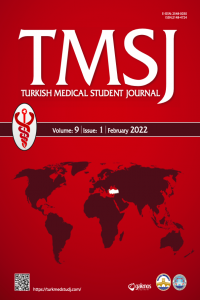INVESTIGATION OF THE PARAMETERS THAT MAY PREDICT HEMODIALYSIS FREQUENCY
INVESTIGATION OF THE PARAMETERS THAT MAY PREDICT HEMODIALYSIS FREQUENCY
___
- 1. Carney EF. The impact of chronic kidney disease on global health. Nat Rev Nephrol 2020;16(5):251.
- 2. Rambod M, Shabani M, Shokrpour N et al. Quality of life of he- modialysis and renal transplantation patients. Health Care Manag 2011;30(1):23-8.
- 3. Jung HY, Jeon Y, Park Y et al. Better quality of life of peritoneal dialysis compared to hemodialysis over a two-year period afterdialysis initiation. Sci Rep 2019;9(1):10266.
- 4. Ng JK, Li PK. Chronic kidney disease epidemic: How do we deal with it? Nephrology 2018;23(4):116-20.
- 5. Li H, Xie L, Yang J et al. Symptom burden amongst patients suffering from end-stage renal disease and receiving dialysis: A literature review. Int J Nurs Sci 2018;5(4):427-31.
- 6. Ricardo AC, Yang W, Sha D et al. Sex-related disparities in CKD progression. J Am Soc Nephrol 2019;30(1):137-46.
- 7. de Sequera P, Corchete E, Bohorquez L et al. Residual renal function in hemodialysis and inflammation. Ther Apher Dial 2017;21(6):592-8.
- ISSN: 2148-4724
- Başlangıç: 2014
- Yayıncı: Trakya Üniversitesi
THE FOURTH HORSEMAN OF 21ST CENTURY: COVID-19 PANDEMIC
İnci KADRİBEY, Fatih Erkan AKAY
PATHOPHYSIOLOGY, CLINICAL FEATURES AND TREATMENT OF MICROVASCULAR ANGINA: A REVIEW
Hasan Selçuk ÖZKAN, Meral KAYIKÇIOĞLU
INVESTIGATION OF THE PARAMETERS THAT MAY PREDICT HEMODIALYSIS FREQUENCY
Gökhan KIRAL, Alperen Taha CERTEL, Irmak İrem ÖZYİĞİT, Begüm SÖYLEYİCİ, Güray AYGÜN, Cenk GÖKALP
THE EFFECT OF 5-FU AND RUXOLITINIB ON MITOCHONDRIAL APOPTOSIS IN GLIOBLASTOMA U87 CELL LINE
Gonca AKSU, Oğuzhan DOĞANLAR, Zeynep Banu DOĞANLAR
Elif CENGİZ, Fevzi Oktay ŞİŞMAN, Beliz KOÇYİĞİT, Mehmet Gürkan ARIKAN, Tevfik AKTOZ
MYOCARDIAL INFARCTION DIAGNOSIS AND CARDIAC TROPONINS
Berra KURTOĞLU, Burcu ERKILIÇ, Dilay Yağmur GÜRSEL, Gülsüm ARSLAN, Ogün BACAKSIZOĞLU, Pınar ALTUNDAL, Selin KARA, Yasemin ARDIÇOĞLU
JUVENILE POLYP FROM SYMPTOM TO DIAGNOSIS AND THE ROLE OF ULTRASONOGRAPHY: A CASE REPORT
Berkin ERSOY, Özdal ERSOY, Haluk AKMAN, Füsun BABA
DISTANCE EDUCATION IN MEDICAL SCHOOLS: THE EXPERIENCE AND OPINIONS OF ACADEMICIANS AND STUDENTS
Hilal Sena ÇİFCİBAŞI, Berkay KEF, Irmak İrem ÖZYİĞİT, Sezin SAYIN, Aslı GÖZTEPE, Selis Gülseven GÜVEN, Serkan ATICI
